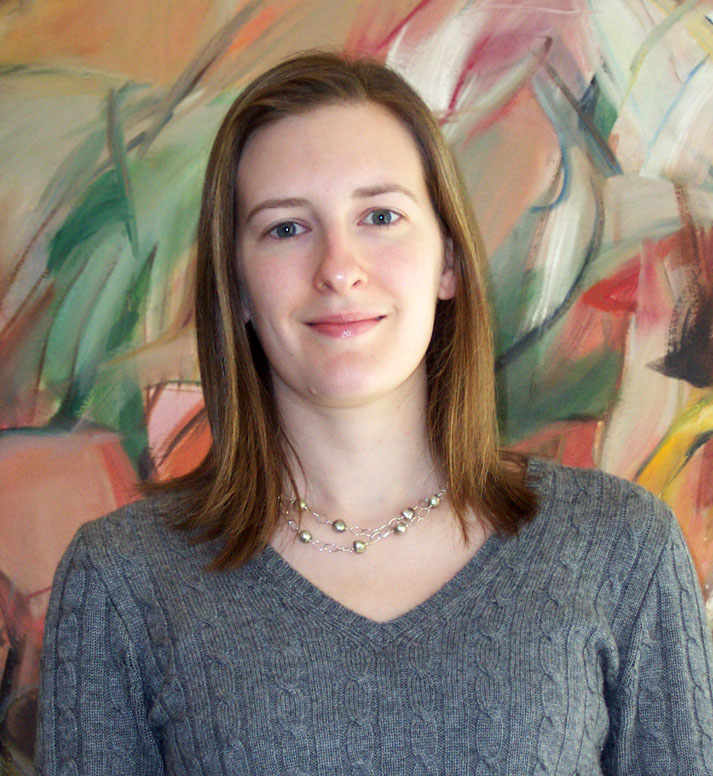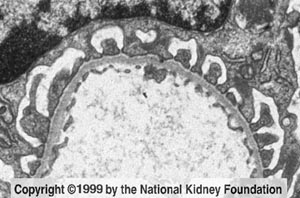
Department of Chemical Engineering
Room 66-463
Massachusetts Institute of Technology
77 Massachusetts Avenue
Cambridge, MA 02139-4307 USA
Telephone (617) 253-6490
Email: kmattern@mit.edu

A microscope view of a cross-section of the glomerular capillary wall.
Smaller endothelial cells and larger epithelial cells border the glomerular
basement membrane (continuous gray band). My research focuses on transport
through the negatively charged glycocalyx layer surrounding the cell walls
of the endothelium.
Kristin Mattern
Graduate Research Assistant
B.S.E., Chemical Engineering, Princeton University, 2000
M.S., Chemical Engineering Practice, MIT, 2001
Research Interests
Glycosaminoglycan-Enriched Membranes for the Study of Renal Filtration
Ultrafiltration of blood plasma across the glomerular capillaries has been understood to be a primary function of the kidneys. This filtration to remove excess solutes and metabolic wastes assures that blood remains at a necessary constant composition and volume. The plasma solutes are selectively filtered on the basis of molecular size, shape and charge. If this selective elimination does not occur properly, one of the many forms of kidney disease can occur, such as proteinuria, in which excessive protein is allowed to pass out of the bloodstream.
The current understanding of which of the three structurally-unique layers of the glomerular capillary wall (endothelium, glomerular basement membrane, or epithelium) contributes to the hydraulic permeability and solute selectivity of the glomerulus remains incomplete. Our lab's general objective seeks a fundamental identification of the factors affecting glomerular permselectivity. Through experimentation and computer modeling using classical transport concepts, we study the hydraulic resistance and molecular sieving characteristics of the separate glomerular layers.
In recent studies on both isolated glomerular basement membrane (GBM) and synthetic analogs, the GBM only partially accounted for solute selectivity across the glomerulus. Research on the epithelium and it's slit diaphragms also could not fully account for the selectivity. However, the endothelial layer, with small pores filled by a matrix of charged proteoglycans, may provide the additional charge selectivity observed in the glomerular capillary wall. Unfortunately the endothelial layer cannot be easily isolated. My research therefore focuses on developing an appropriate synthetic analog to the proteoglycan matrix and characterizing its effects on hydraulic permeability and solute sieving. In our current work we are attaching negatively charged glycosaminoglycans (GAGs) to a neutral agarose gel membrane. Techniques previously used in our lab will soon be used to measure the hydraulic permeability, solute partition and solute sieving coefficients while varying gel density and charge, as well as solute size and charge. A model for transport of charged molecules within a charged random fiber matrix will be developed, and both the experimental data and the model will determine if the properties of the endothelial layer can account for the hydraulic permeability and solute selectivity not accounted for by the GBM. Once we have a fundamental understanding of the basis for renal ultrafiltration, this knowledge can be used by other groups to interpret clinical observations of renal disease, improve dialysis membranes, or selectively identify targets and treatments for renal disorders.
Personal Interests
My personal interest in this area has grown from an enjoyment of transport courses during my undergraduate and master's years. When I returned to graduate school, I wanted to find a project which would allow me to continue in this area while incorporating biological aspects. This project combines these areas and also offers the good balance between experimental and modeling work that promotes a well-rounded knowledge. My research in renal biology and transport has increased my amazement at the intricacies of human physiology, as well as led to many interesting conversations on how our kidneys are truly the ultimate Brita® filter.
Outside of research, I've tried to take advantage of all MIT and the surrounding area has to offer. I've been a potter for several years, enjoy hiking and skiing in the White Mountains, have played IM volleyball, volunteer with various educational and environmental groups, and love baking (currently a two-time winner of the ChemE Christmas baking contest).